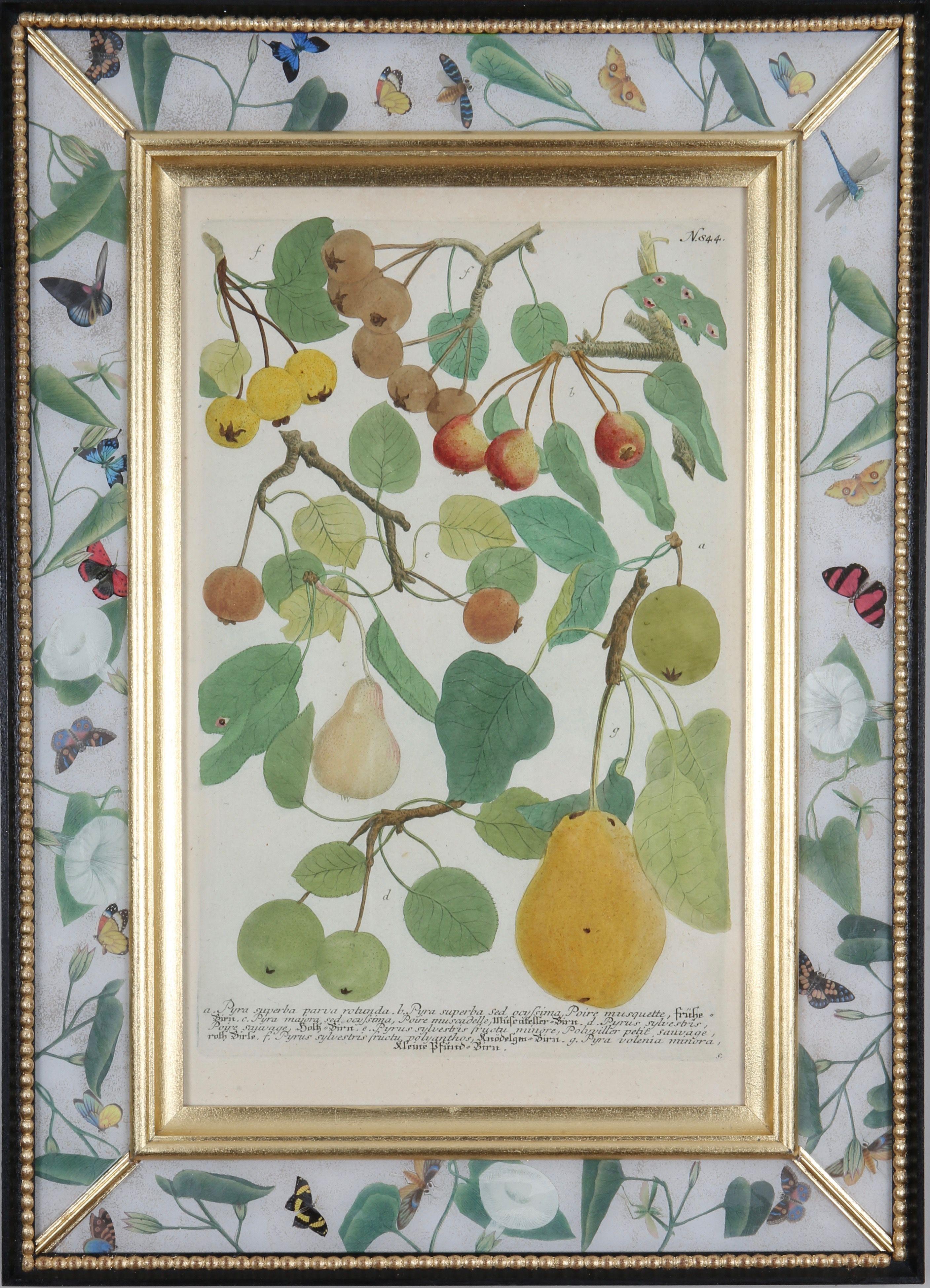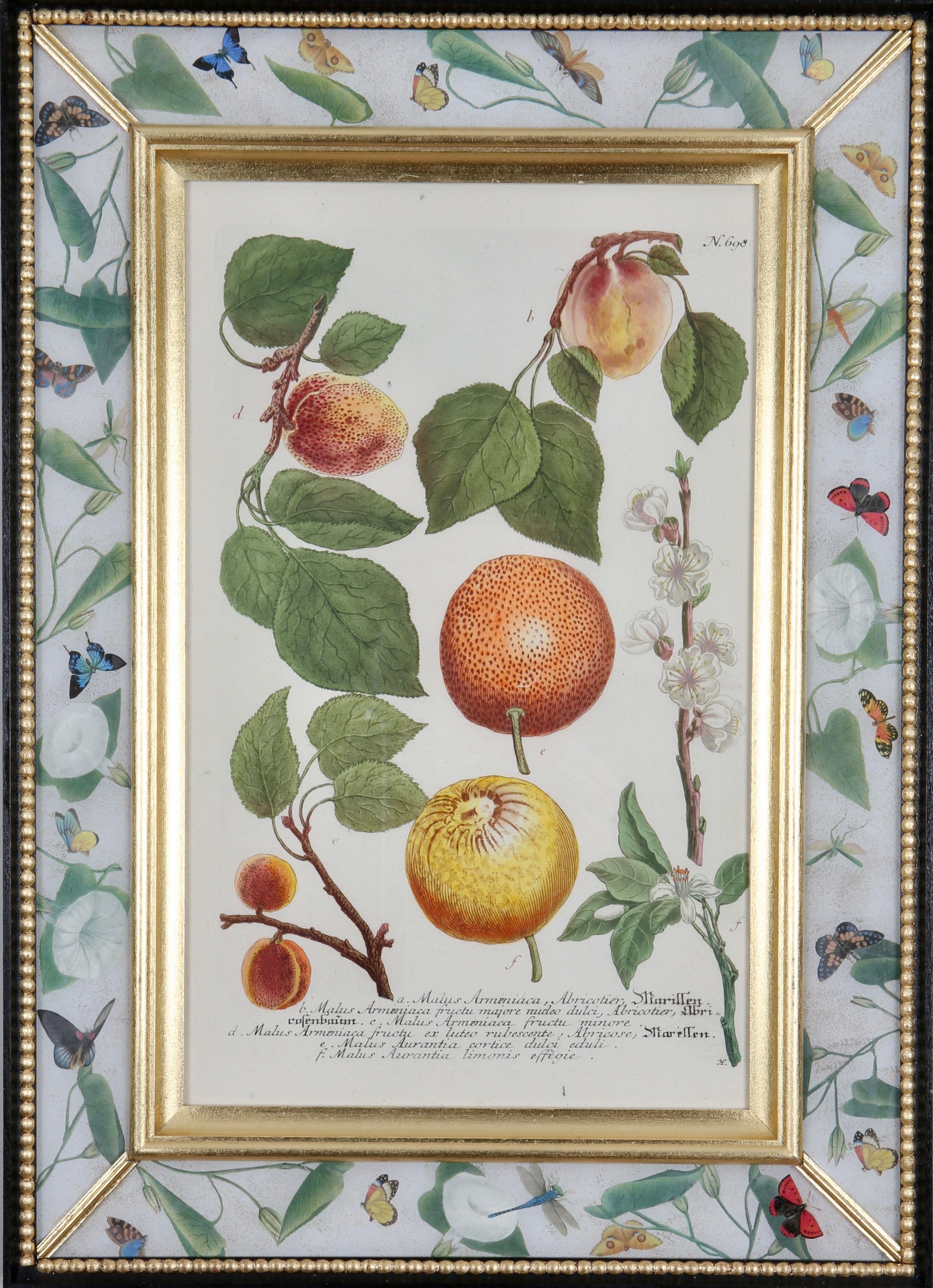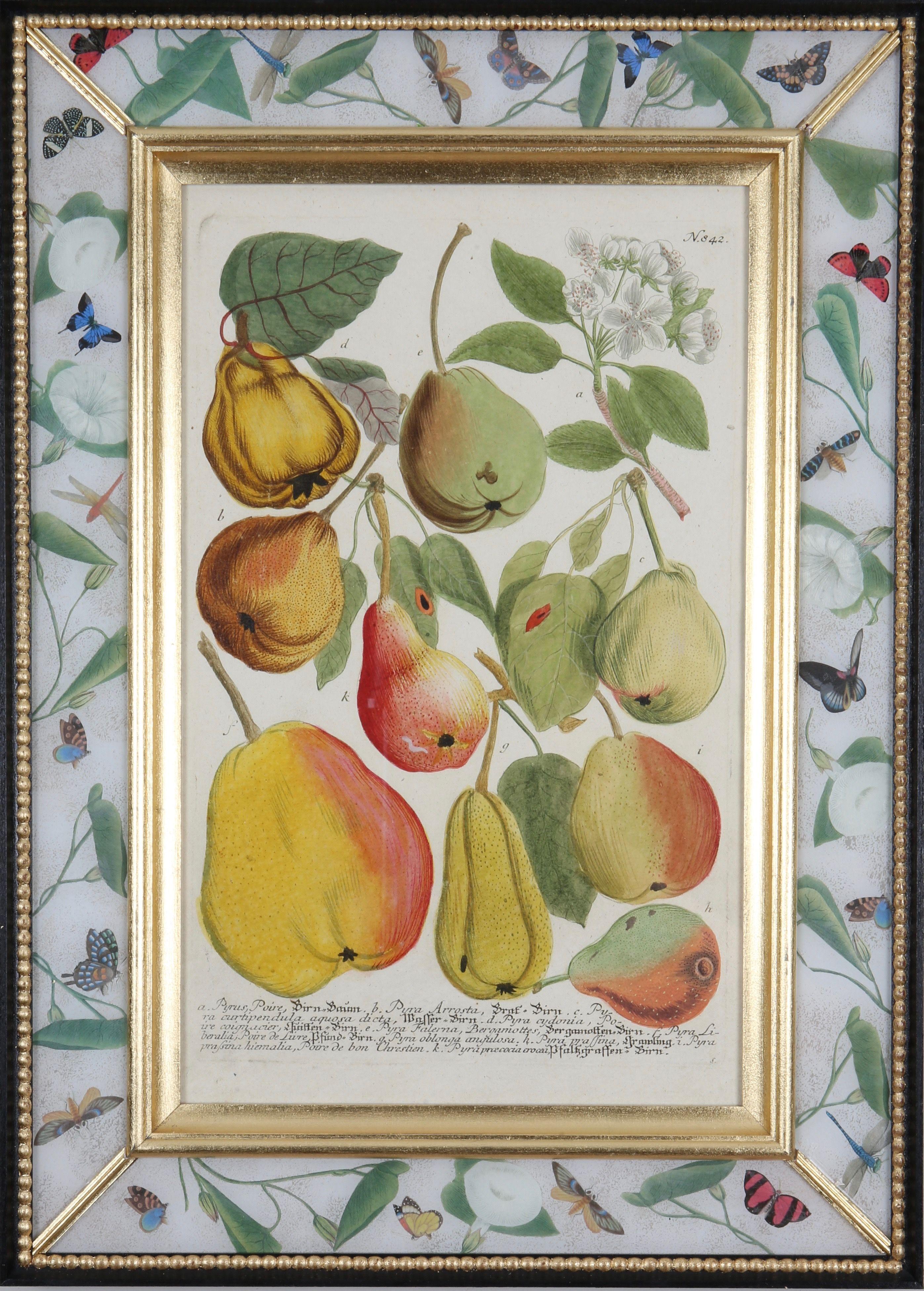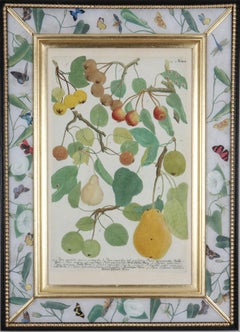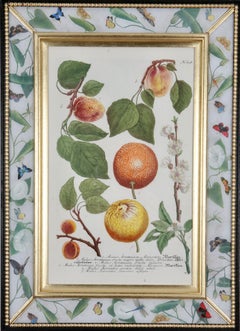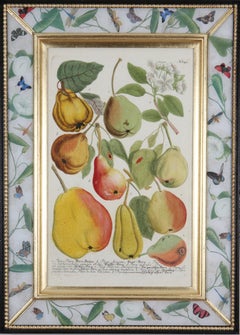Items Similar to George Brookshaw (1751-1823), Fruit Cluster, PL XII
Want more images or videos?
Request additional images or videos from the seller
1 of 8
George Brookshaw George Brookshaw (1751-1823), Fruit Cluster, PL XII
$1,200
£909.23
€1,043.27
CA$1,688.59
A$1,856.23
CHF 975.55
MX$22,541.38
NOK 12,169.73
SEK 11,529.96
DKK 7,786.16
About the Item
Print Sz: 11 1/2"H x 9 1/2"W
Frame Sz: 19 1/4"H x 16 3/4"W
Publisher: Longman, Hurst, Rees, Orme & Brown
Plate XII
George Brookshaw, also known as G. Brown, was a notable English painter and illustrator from London. His early career was spent as a London cabinet-maker specializing in painted furniture, often with floral decorations. Brookshaw also published supplementary drawing manuals on fruit, flowers, and birds.
Pomona Britannicaa London
1804-1812
Engravings with original hand-coloring
George Brookshaw's splendid "Pomona Brittanica" is a masterpiece among 19th-century British flower books. The publication of the "Pomona" marked the re-emergence of the acclaimed artist into the public eye after a total disappearance of nearly a decade. Initially a cabinet-make specializing in painted furniture decorated with borders of flowers, Brookshaw appears to have abandoned this career at about the same time as he parted company with his wife and began living with Elizabeth Stanton, and under the assumed name of G. Brown (c.1794-1804). During this time he earned a living as a teacher of flower-painting and on the proceeds of his first painting manual "A New Treatise on Flower Painting", 1797. Characterized by the highest standards of production and artistic quality, the superb illustrations that Brookshaw drew and engraved for the "Pomona" remain perhaps the most sumptuous and distinctive of the early 19th century. This magnificent and stylistically unique work took Brookshaw nearly ten years to produce. Rivaled only by Dr. Robert Thornton's "Temple of Flora," Brookshaw's 'Pomona' is considered to be the finest British botanical work from a time when England dominated the field with a very large number of great books. Brookshaw's fine illustrations make excellent use of the rich, modulated tones that the aquatint process creates. The elegantly arranged and richly colored fruits emerge from deep brown backgrounds or float on a softly mottled light ground, creating a presence unlike that of any other botanical illustrations. Brookshaw asserts in the preface that the "Pomona Britannica" was an enduring work created for the enjoyment and edification of "succeeding generations."
About the Seller
4.8
Vetted Professional Seller
Every seller passes strict standards for authenticity and reliability
Established in 2000
1stDibs seller since 2019
131 sales on 1stDibs
Typical response time: 1 hour
- ShippingRetrieving quote...Shipping from: Bristol, CT
- Return Policy
Authenticity Guarantee
In the unlikely event there’s an issue with an item’s authenticity, contact us within 1 year for a full refund. DetailsMoney-Back Guarantee
If your item is not as described, is damaged in transit, or does not arrive, contact us within 7 days for a full refund. Details24-Hour Cancellation
You have a 24-hour grace period in which to reconsider your purchase, with no questions asked.Vetted Professional Sellers
Our world-class sellers must adhere to strict standards for service and quality, maintaining the integrity of our listings.Price-Match Guarantee
If you find that a seller listed the same item for a lower price elsewhere, we’ll match it.Trusted Global Delivery
Our best-in-class carrier network provides specialized shipping options worldwide, including custom delivery.More From This Seller
View AllGeorge Brookshaw (1751-1823), Apple Cluster, PL LX
Located in Bristol, CT
Print Sz: 11 1/2"H x 9 1/2"W
Frame Sz: 19 1/4"H x 16 3/4"W
Publisher: Longman, Hurst, Rees, Orme & Brown
Plate LX
George Brookshaw, also known as G. Brown, was a notable English painter and illustrator from London. His early career was spent as a London cabinet-maker specializing in painted furniture, often with floral decorations. Brookshaw also published supplementary drawing manuals on fruit, flowers, and birds.
Pomona Britannicaa London
1804-1812
Engravings with original hand-coloring
George Brookshaw's splendid "Pomona Brittanica" is a masterpiece among 19th-century British flower books. The publication of the "Pomona" marked the re-emergence of the acclaimed artist into the public eye after a total disappearance of nearly a decade. Initially a cabinet-make specializing in painted furniture decorated with borders of flowers, Brookshaw appears to have abandoned this career at about the same time as he parted company with his wife and began living with Elizabeth Stanton, and under the assumed name of G. Brown (c.1794-1804). During this time he earned a living as a teacher of flower-painting and on the proceeds of his first painting manual "A New Treatise on Flower Painting", 1797. Characterized by the highest standards of production and artistic quality, the superb illustrations that Brookshaw drew and engraved for the "Pomona" remain perhaps the most sumptuous and distinctive of the early 19th century. This magnificent and stylistically unique work took Brookshaw nearly ten years to produce. Rivaled only by Dr. Robert Thornton...
Category
Early 1800s Still-life Prints
Materials
Engraving
George Brookshaw (1751-1823), Pear Cluster, PL XLIX
Located in Bristol, CT
Print Sz: 11 1/2"H x 9 1/2"W
Frame Sz: 19 1/4"H x 16 3/4"W
Publisher: Longman, Hurst, Rees, Orme & Brown
Plate XLIX
George Brookshaw, also known as G. Brown, was a notable Englis...
Category
Early 1800s Still-life Prints
Materials
Engraving
George Brookshaw (1751-1823), Cherry Cluster, PL V
Located in Bristol, CT
Print Sz: 11 1/2"H x 9 1/2"W
Frame Sz: 19 1/4"H x 16 3/4"W
Publisher: Longman, Hurst, Rees, Orme & Brown
Plate V
George Brookshaw, also known as G. Brown, was a notable English painter and illustrator from London. His early career was spent as a London cabinet-maker specializing in painted furniture, often with floral decorations. Brookshaw also published supplementary drawing manuals on fruit, flowers, and birds.
Pomona Britannicaa London
1804-1812
Engravings with original hand-coloring
George Brookshaw's splendid "Pomona Brittanica" is a masterpiece among 19th-century British flower books. The publication of the "Pomona" marked the re-emergence of the acclaimed artist into the public eye after a total disappearance of nearly a decade. Initially a cabinet-make specializing in painted furniture decorated with borders of flowers, Brookshaw appears to have abandoned this career at about the same time as he parted company with his wife and began living with Elizabeth Stanton, and under the assumed name of G. Brown (c.1794-1804). During this time he earned a living as a teacher of flower-painting and on the proceeds of his first painting manual "A New Treatise on Flower Painting", 1797. Characterized by the highest standards of production and artistic quality, the superb illustrations that Brookshaw drew and engraved for the "Pomona" remain perhaps the most sumptuous and distinctive of the early 19th century. This magnificent and stylistically unique work took Brookshaw nearly ten years to produce. Rivaled only by Dr. Robert Thornton...
Category
Early 1800s Still-life Prints
Materials
Engraving
George Brookshaw (1751-1823), Blue Muscadine Grape, PL XXXVIII
Located in Bristol, CT
Print Sz: 11 1/2"H x 9 1/2"W
Frame Sz: 19 1/4"H x 16 3/4"W
Publisher: Longman, Hurst, Rees, Orme & Brown
Plate XXXVIII
George Brookshaw, also known as G. Brown, was a notable Eng...
Category
Early 1800s Still-life Prints
Materials
Engraving
George Brookshaw (1751-1823), Black Apricot; Breda Apricot; Brussels Moor Park A
Located in Bristol, CT
Print Sz: 11 1/2"H x 9 1/2"W
Frame Sz: 19 1/4"H x 16 3/4"W
Publisher: Longman, Hurst, Rees, Orme & Brown
Plate XX
George Brookshaw, also known as G. Brown, was a notable English ...
Category
Early 1800s Still-life Prints
Materials
Engraving
"Rustics By A Lake" by Paul Sandby (1730-1809)
By Paul Sandby
Located in Bristol, CT
Art Sz: 6"H x 6 1/4"W
Frame Sz: 15 1/4"H x 15 1/4"W
In coral mat w/ lacquer birdseye maple frame
Classic drawing in blue and grey washes over pencil on laid paper depicting two 'rustics by a lake' by the British artist Paul Sandby (1730-1809) whose works are represented in The Royal Collection at Windsor Castle. Provenance: The Cornish Torbock Collection Sotheby's London 14th April 1994, Lot 226/ Hubert Peake, Christie's 26th May 1959, Lot 51/ Colonel W. Gravatt 1867
Paul Sandby RA (1731 – 7 November 1809) was an English map-maker turned landscape painter in watercolours, who, along with his older brother...
Category
Late 18th Century Drawings and Watercolor Paintings
Materials
Pencil
You May Also Like
Johann Weinmann: c.18th Engraving of Fruit in a Decalcomania Frame.
Located in Richmond, GB
Hand-coloured mezzotint engravings from: ""Phytanthoza Iconographia"", c1739, presented in hand-made parcel-gilt, ebonised and decalcomania frames.
Johann Weinmann (1683-1741), a G...
Category
18th Century Figurative Prints
Materials
Watercolor, Mezzotint
Johann Weinmann: c.18th Engraving of Fruit in a Decalcomania Frame.
Located in Richmond, GB
Hand-coloured mezzotint engravings from: ""Phytanthoza Iconographia"", c1739, presented in hand-made parcel-gilt, ebonised and decalcomania frames.
Johann Weinmann (1683-1741), a G...
Category
18th Century Figurative Prints
Materials
Watercolor, Mezzotint
Johann Weinmann: c.18th Engraving of Fruit in a Decalcomania Frame.
Located in Richmond, GB
Hand-coloured mezzotint engravings from: ""Phytanthoza Iconographia"", c1739, presented in hand-made parcel-gilt, ebonised and decalcomania frames.
Johann Weinmann (1683-1741), a G...
Category
18th Century Figurative Prints
Materials
Watercolor, Mezzotint
Johann Weinmann: c.18th Engraving of Fruit in a Decalcomania Frame.
Located in Richmond, GB
Hand-coloured mezzotint engravings from: ""Phytanthoza Iconographia"", c1739, presented in hand-made parcel-gilt, ebonised and decalcomania frames.
Johann Weinmann (1683-1741), a G...
Category
18th Century Figurative Prints
Materials
Watercolor, Mezzotint
Johann Weinmann: c.18th Engraving of Fruit in a Decalcomania Frame.
Located in Richmond, GB
Hand-coloured mezzotint engravings from: ""Phytanthoza Iconographia"", c1739, presented in hand-made parcel-gilt, ebonised and decalcomania frames.
Johann Weinmann (1683-1741), a G...
Category
18th Century Figurative Prints
Materials
Watercolor, Mezzotint
Johann Weinmann: c.18th Engraving of Fruit in a Decalcomania Frame.
Located in Richmond, GB
Hand-coloured mezzotint engravings from: ""Phytanthoza Iconographia"", c1739, presented in hand-made parcel-gilt, ebonised and decalcomania frames.
Johann Weinmann (1683-1741), a G...
Category
18th Century Figurative Prints
Materials
Watercolor, Mezzotint
More Ways To Browse
Antique Engravings London
Antique Hurst
Hamaguchi Mezzotints
Hodo Nishimura
Inoue Kozo
Japanese Print Yokohama
Kenny Scharf Flores
Kerry Day
Lemon Engraving
Matthaus Merian The Elder
Andy Warhol Skull
Andy Warhol Space Fruit
Christo Bottle
Georgia O Keeffe Flowers
Henri De La Pensee
Nicholas Robert Print
Pierre Pivet
Raoul Dufy Scarf
